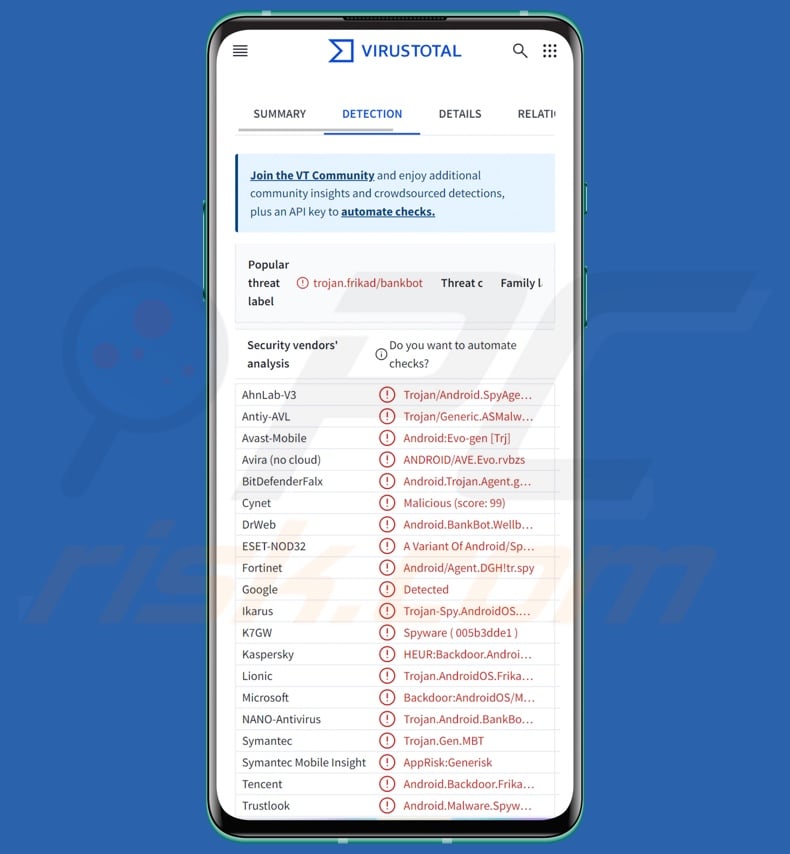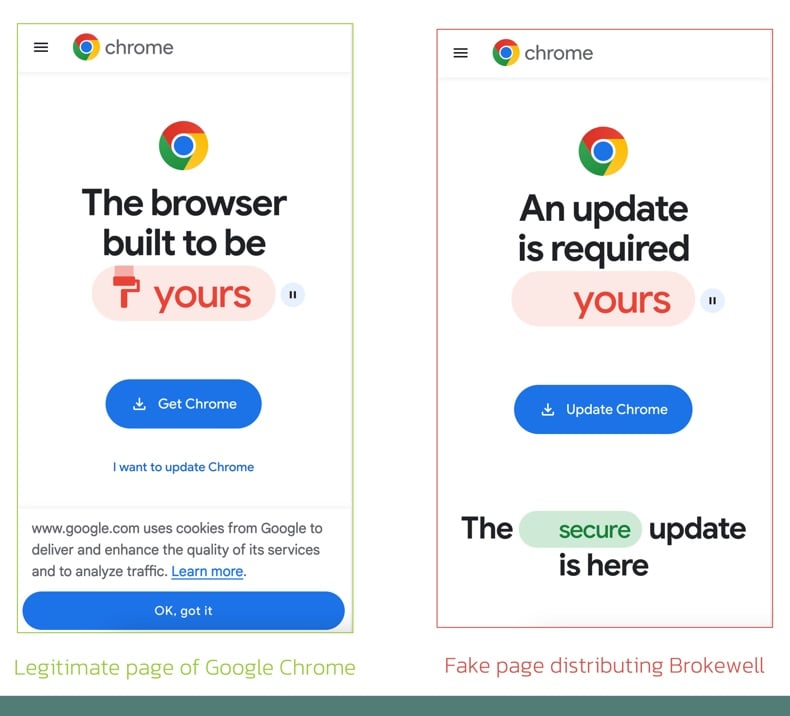How to remove the Brokewell malware from your Android device
![]() Written by Tomas Meskauskas on
Written by Tomas Meskauskas on
What kind of malware is Brokewell?
Brokewell is a banking malware with spyware and RAT (Remote Access Trojan) capabilities. This malicious program targets Android operating systems. As is indicated by its classification, Brokewell seeks banking-related information. At the time of writing, the malware is in active development and is receiving frequent updates.

Brokewell malware overview
Brokewell is a banking malware that has significant crossover with RATs (Remote Access Trojans). These programs are designed to allow remote access/control over infected devices.
Brokewell can execute a wide variety of commands on compromised systems. Some commands of note include: screen touches/swipes/presses, waking the device, adjusting brightness and volume, inputting text, simulating vibration, etc. These capabilities enable the malware to carry out various activities on victims' devices.
Additionally, Brokewell has functionalities associated with spyware. It collects relevant device data, geolocation-related details, call logs, etc. This trojan is also capable of recording audio via microphones and the screen (live-streaming). Brokewell monitors victims' activities by tracking touches, swipes, presses, text input, opened applications, etc.
As a banking malware, Brokewell extracts the log-in credentials of online bank apps and other financial software by displaying phishing screens over them (i.e., overlay attacks). These sign-in pages appear legitimate and record information entered into them. Brokewell also gathers Internet cookies.
It is pertinent to mention that malware developers commonly improve their software and methodologies. As mentioned in the introduction, this banking malware is being updated frequently. Hence, future iterations of Brokewell can have additional/different abilities and features.
To summarize, the presence of malicious software like Brokewell on devices can result in severe privacy issues, financial losses, and identity theft.
| Name | Brokewell malware |
| Threat Type | Android malware, malicious application, banking trojan. |
| Detection Names | Avast-Mobile (Android:Evo-gen [Trj]), DrWeb (Android.BankBot.Wellbroke.1.origin), ESET-NOD32 (A Variant Of Android/Spy.Agent.DGH), Fortinet (Android/Agent.DGH!tr.spy), Kaspersky (HEUR:Backdoor.AndroidOS.Frikad.a), Full List (VirusTotal) |
| Symptoms | Trojans are designed to stealthily infiltrate the victim's computer and remain silent, and thus no particular symptoms are clearly visible on an infected machine. |
| Distribution methods | Fake software updates, infected email attachments, malicious online advertisements, social engineering, deceptive applications, scam websites. |
| Damage | Stolen personal information (private messages, logins/passwords, etc.), decreased device performance, battery is drained quickly, decreased Internet speed, huge data losses, monetary losses, stolen identity (malicious apps might abuse communication apps). |
| Malware Removal (Android) | To eliminate possible malware infections, scan your mobile device with legitimate antivirus software. Our security researchers recommend using Combo Cleaner. |
Android-specific banking malware examples
Greenbean, Iranian banking trojan, and TrickMo are just a couple of our latest articles on Android-targeting banking trojans. Financial information is often sought by malware; data-stealing programs can aim to obtain incredibly specific details or a broad range of information.
However, regardless of what or even if malware can steal data – its presence on a system threatens device integrity and user safety. Therefore, all threats must be removed immediately upon detection.
How did Brokewell infiltrate my device?
Brokewell has been observed being spread via fake Google Chrome browser updates. Other disguises and distribution methods are likely.
Generally, malware is proliferated using phishing and social engineering tactics. Malicious software can be presented as or bundled with legitimate/ordinary content.
The most widespread malware distribution techniques include: drive-by (stealthy/deceptive) downloads, dubious download sources (e.g., freeware and third-party websites, P2P sharing networks, etc.), fake updates, illegal program activation tools ("cracks"), pirated software/media, malicious attachments/links in spam mail (e.g., emails, DMs/PMs, SMSes, etc.), online scams, and malvertising.
Some malicious programs can even self-proliferate via local networks and removable storage devices (e.g., external hard drives, USB flash drives, etc.).
It is noteworthy that cyber criminals can use legitimate download channels (like the Google Play Store, etc.) to host malware. While the malicious content can be swiftly removed from such platforms, criminals may still find it lucrative despite the brief hosting period.
How to avoid installation of malware?
We strongly recommend researching software prior to downloading/purchasing, e.g., by reading terms and user/expert reviews, checking required permissions, verifying developer legitimacy, etc. Additionally, all downloads must be made from official and trustworthy sources. Programs must be activated and updated using legitimate functions/tools, as illegal activation ("cracking") tools and third-party updates can contain malware.
Another recommendation is to be vigilant while browsing since fraudulent and malicious online content usually appears genuine and harmless. We advise treating incoming emails and other messages with caution. Attachments or links present in suspect/irrelevant mail must not be opened, as they can be infectious.
It is paramount for device/user safety to have a dependable anti-virus installed and kept updated. This software must be used to perform regular system scans and to remove threats and issues.
Appearance of a legitimate Chrome page and the fake update spreading Brokewell (image source – ThreatFabric):

Quick menu:
- Introduction
- How to delete browsing history from the Chrome web browser?
- How to disable browser notifications in the Chrome web browser?
- How to reset the Chrome web browser?
- How to delete browsing history from the Firefox web browser?
- How to disable browser notifications in the Firefox web browser?
- How to reset the Firefox web browser?
- How to uninstall potentially unwanted and/or malicious applications?
- How to boot the Android device in "Safe Mode"?
- How to check the battery usage of various applications?
- How to check the data usage of various applications?
- How to install the latest software updates?
- How to reset the system to its default state?
- How to disable applications that have administrator privileges?
Delete browsing history from the Chrome web browser:

Tap the "Menu" button (three dots on the right-upper corner of the screen) and select "History" in the opened dropdown menu.

Tap "Clear browsing data", select "ADVANCED" tab, choose the time range and data types you want to delete and tap "Clear data".
Disable browser notifications in the Chrome web browser:

Tap the "Menu" button (three dots on the right-upper corner of the screen) and select "Settings" in the opened dropdown menu.

Scroll down until you see "Site settings" option and tap it. Scroll down until you see "Notifications" option and tap it.

Find the websites that deliver browser notifications, tap on them and click "Clear & reset". This will remove permissions granted for these websites to deliver notifications. However, once you visit the same site again, it may ask for a permission again. You can choose whether to give these permissions or not (if you choose to decline the website will go to "Blocked" section and will no longer ask you for the permission).
Reset the Chrome web browser:

Go to "Settings", scroll down until you see "Apps" and tap it.

Scroll down until you find "Chrome" application, select it and tap "Storage" option.

Tap "MANAGE STORAGE", then "CLEAR ALL DATA" and confirm the action by taping "OK". Note that resetting the browser will eliminate all data stored within. This means that all saved logins/passwords, browsing history, non-default settings and other data will be deleted. You will also have to re-login into all websites as well.
Delete browsing history from the Firefox web browser:

Tap the "Menu" button (three dots on the right-upper corner of the screen) and select "History" in the opened dropdown menu.

Scroll down until you see "Clear private data" and tap it. Select data types you want to remove and tap "CLEAR DATA".
Disable browser notifications in the Firefox web browser:

Visit the website that is delivering browser notifications, tap the icon displayed on the left of URL bar (the icon will not necessarily be a "Lock") and select "Edit Site Settings".

In the opened pop-up opt-in the "Notifications" option and tap "CLEAR".
Reset the Firefox web browser:

Go to "Settings", scroll down until you see "Apps" and tap it.

Scroll down until you find "Firefox" application, select it and tap "Storage" option.

Tap "CLEAR DATA" and confirm the action by taping "DELETE". Note that resetting the browser will eliminate all data stored within. This means that all saved logins/passwords, browsing history, non-default settings and other data will be deleted. You will also have to re-login into all websites as well.
Uninstall potentially unwanted and/or malicious applications:

Go to "Settings", scroll down until you see "Apps" and tap it.

Scroll down until you see a potentially unwanted and/or malicious application, select it and tap "Uninstall". If, for some reason, you are unable to remove the selected app (e.g., you are prompted with an error message), you should try using the "Safe Mode".
Boot the Android device in "Safe Mode":
The "Safe Mode" in Android operating system temporarily disables all third-party applications from running. Using this mode is a good way to diagnose and solve various issues (e.g., remove malicious applications that prevent users you from doing so when the device is running "normally").

Push the "Power" button and hold it until you see the "Power off" screen. Tap the "Power off" icon and hold it. After a few seconds the "Safe Mode" option will appear and you'll be able run it by restarting the device.
Check the battery usage of various applications:

Go to "Settings", scroll down until you see "Device maintenance" and tap it.

Tap "Battery" and check the usage of each application. Legitimate/genuine applications are designed to use as low energy as possible in order to provide the best user experience and to save power. Therefore, high battery usage may indicate that the application is malicious.
Check the data usage of various applications:

Go to "Settings", scroll down until you see "Connections" and tap it.

Scroll down until you see "Data usage" and select this option. As with battery, legitimate/genuine applications are designed to minimize data usage as much as possible. This means that huge data usage may indicate presence of malicious application. Note that some malicious applications might be designed to operate when the device is connected to wireless network only. For this reason, you should check both Mobile and Wi-Fi data usage.

If you find an application that uses a lot of data even though you never use it, then we strongly advise you to uninstall it as soon as possible.
Install the latest software updates:
Keeping the software up-to-date is a good practice when it comes to device safety. The device manufacturers are continually releasing various security patches and Android updates in order to fix errors and bugs that can be abused by cyber criminals. An outdated system is way more vulnerable, which is why you should always be sure that your device's software is up-to-date.

Go to "Settings", scroll down until you see "Software update" and tap it.

Tap "Download updates manually" and check if there are any updates available. If so, install them immediately. We also recommend to enable the "Download updates automatically" option - it will enable the system to notify you once an update is released and/or install it automatically.
Reset the system to its default state:
Performing a "Factory Reset" is a good way to remove all unwanted applications, restore system's settings to default and clean the device in general. However, you must keep in mind that all data within the device will be deleted, including photos, video/audio files, phone numbers (stored within the device, not the SIM card), SMS messages, and so forth. In other words, the device will be restored to its primal state.
You can also restore the basic system settings and/or simply network settings as well.

Go to "Settings", scroll down until you see "About phone" and tap it.

Scroll down until you see "Reset" and tap it. Now choose the action you want to perform:
"Reset settings" - restore all system settings to default;
"Reset network settings" - restore all network-related settings to default;
"Factory data reset" - reset the entire system and completely delete all stored data;
Disable applications that have administrator privileges:
If a malicious application gets administrator-level privileges it can seriously damage the system. To keep the device as safe as possible you should always check what apps have such privileges and disable the ones that shouldn't.

Go to "Settings", scroll down until you see "Lock screen and security" and tap it.

Scroll down until you see "Other security settings", tap it and then tap "Device admin apps".

Identify applications that should not have administrator privileges, tap them and then tap "DEACTIVATE".
Frequently Asked Questions (FAQ)
My Android device is infected with Brokewell malware, should I format my storage device to get rid of it?
Malware removal rarely requires formatting.
What are the biggest issues that Brokewell malware can cause?
The threats associated with an infection depend on the malicious program's functionalities and the cyber criminals' modus operandi. Brokewell is a sophisticated banking trojan that targets finance-related data, and can perform various activities on devices, even record information. Such high-risk infections can lead to serious privacy issues, financial losses, and identity theft.
What is the purpose of Brokewell malware?
Malware is primarily used to generate revenue, and as Brokewell seeks banking-related information – it is no exception. However, malware attacks can also be motivated by cyber criminals seeking amusement, personal grudges, process disruption (e.g., websites, services, companies, organizations, etc.), hacktivism, and political/geopolitical reasons.
How did Brokewell malware infiltrate my Android device?
Brokewell has been proliferated under the guise of Google Chrome updates. However, other disguises/methods are not unlikely. Generally, malware is spread via drive-by downloads, fake updates, untrustworthy download channels (e.g., freeware and third-party sites, P2P sharing networks, etc.), online scams, malvertising, spam mail, and illegal software activation tools ("cracks"). Furthermore, some malicious programs can self-proliferate through local networks and removable storage devices.
Will Combo Cleaner protect me from malware?
Yes, Combo Cleaner is capable of detecting and eliminating nearly all known malware infections. Note that since sophisticated malicious software usually hides deep within systems – performing a complete system scan is essential.


▼ Show Discussion